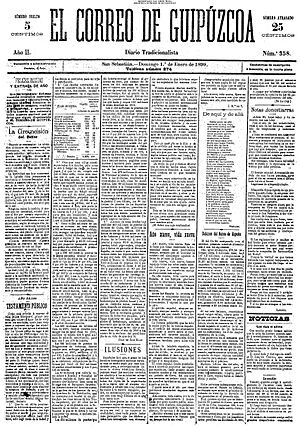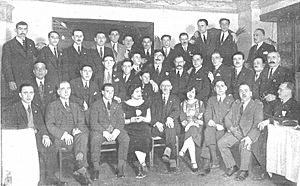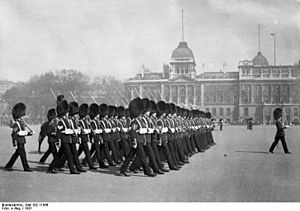Román Oyarzun Oyarzun facts for kids
Quick facts for kids
Román Oyarzun Oyarzun
|
|
|---|---|
 |
|
| Born |
Román Oyarzun Oyarzun
1882 Olagüe, Spain
|
| Died | 1968 Pamplona, Spain
|
| Nationality | Spanish |
| Occupation | lawyer, entrepreneur, publisher, public servant |
| Known for | historian |
| Political party | Carlism |
Román Oyarzun Oyarzun (1882–1968) was a Spanish writer, diplomat, and businessman. He is most famous for his book Historia del Carlismo (1939). This book was a very important source for learning about the history of Carlism for many years. Today, it is still seen as a classic book about Traditionalist history.
Román Oyarzun also worked for the Spanish government in other countries. He was briefly the editor of a newspaper called El Correo de Guipúzcoa. He was also a member of the Carlist movement himself.
Contents
Román Oyarzun's Early Life and Family
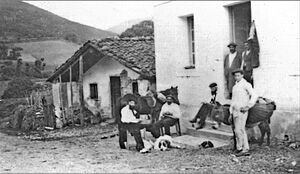
The Oyarzun family came from a region in northern Navarre, Spain. This area is near the Pyrenees mountains. Román's family were Basque and worked on farms around a small village called Olagüe.
His father, Juan Miguel Oyarzun Seminario (1856-1908), started a small business. He used mules to transport goods across the land. Later, in the early 1900s, he owned a few shops. Juan Miguel married Patricia Oyarzun, a local girl. They lived in Olagüe and had at least three children: Román, Martina, and Victoriano.
The family was very religious and strong in their Catholic faith. They were part of a movement called Integrism, which was a very strict form of Catholicism. They even signed letters protesting how the Pope was treated. These letters were printed in a newspaper.
Román's Education and First Jobs
We don't know much about Román's very early schooling. But he loved to write from a young age. In 1893, when he was just 11, he sent a story to a newspaper in Pamplona. The newspaper published it and asked him to write more.
In 1902, he was an excellent student at the Pamplona Instituto Provincial. This might mean he studied to become a teacher. Later, he went to Universidad Central in Madrid. He studied law and finished his degree very quickly. Then he studied philosophy and literature, graduating in 1905.
In 1908, Román started working as an editor for a newspaper in San Sebastián. The newspaper was called El Correo de Guipúzcoa.
Román's Marriage and Children
In 1911, Román Oyarzun married María de la Concepción Iñarra Sasa (1884-1979). They settled in Pamplona, where Román worked as a lawyer. They had five children between 1912 and 1923.
Many of Román's children and grandchildren followed in his footsteps. His sons, Román Oyarzun Iñarra and Francisco Javier, worked as diplomats for Spain. They served in many countries, especially in Latin America. Francisco Javier also became a historian.
María Oyarzun Iñarra became an archivist, someone who organizes historical records. Socorro Oyarzun Iñarra was a painter. Teresa Oyarzun Iñarra worked as a translator. Román Oyarzun Marchesi, one of his grandsons, also became a diplomat and ambassador.
Román's Early Carlist Activities
Román grew up with Traditionalist ideas. During his university years, he joined the Juventud Carlista, a youth group for the Carlist movement. When he returned to Pamplona, he became active in the party. He was known for his knowledge and gave speeches to local groups.
In 1908, Oyarzun moved to San Sebastián to work for El Correo de Guipúzcoa. This newspaper was owned by a Carlist leader. Román became the editor-in-chief. He made sure the newspaper supported Traditionalist ideas.
He also helped organize a large meeting in 1908. This meeting, called Acto de Zumárraga, asked for the old laws of Gipuzkoa (called fueros) to be brought back. About 25,000 people attended. After the event, the newspaper published articles that led to Oyarzun being taken to court. He defended himself as a lawyer and was found not guilty. Two years later, he left the newspaper and returned to Pamplona.
Meeting the Carlist King
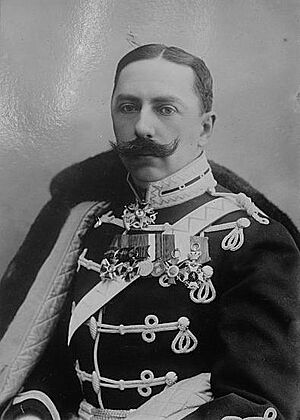
In 1910, a Carlist leader encouraged Román to visit the Carlist king, Don Jaime. Don Jaime lived in Austria. Román spent about two months with the king, working as a temporary secretary. They got along well, and the king offered Román a permanent job. However, Román declined because he was planning to get married.
Román's time in Austria led to some letters he sent to newspapers in Navarre. In these letters, he praised Don Jaime. Román returned to Navarre to defend some Carlists who were facing trial. He successfully defended them. After this, Román's political activities paused for a while. He began working as a diplomat and later focused on business.
Román's Professional Career
In 1911, Román Oyarzun decided to take exams to join the Spanish consular service. He passed the exams. He promised the Carlist king that he would leave his public duties if needed. Later that year, he joined the consular corps. By 1912, he was a vice-consul in Liverpool, England. He stayed there until 1914.
In 1914 or 1915, he was promoted and sent to Rio de Janeiro, Brazil. He worked there as a commercial attaché, helping with trade between Spain and Brazil. He held this job until 1919, when he asked for a break.
Starting a Business
In 1919, Oyarzun returned to Spain to start his own business. He created a company called Alpha S.A. This company imported and sold special machines. It had offices in major Spanish cities like Madrid, Barcelona, and Valencia.
At first, the business sold many different products, from small tools to tractors. By the early 1920s, the company was called Román Oyarzun y Cía. It focused on selling high-quality electric kitchen appliances for homes and restaurants. These included dishwashers, mincers, mixers, coffee machines, and cash registers.
Oyarzun used his experience as a commercial attaché to grow his business. By 1928, he was a wealthy businessman with his own car and driver. In 1932, he moved his company into a large building in Madrid. This building also served as a place to assemble machines. His company also did business in Portugal and North Africa.
Returning to Diplomatic Work
Even with a successful business, Oyarzun applied to return to consular service in 1931. He was accepted and sent to London as a commercial attaché. We don't know exactly how long he stayed in London. Some sources say he also worked as a consul in Nice, France.
In 1934, he was appointed to Vienna, Austria. He was promoted to first secretary of the Spanish embassy there. He also continued his role as a commercial attaché, covering trade with Austria, Hungary, and Czechoslovakia. He started these duties in early 1935.
Román's Later Carlist Activities
Before the 1931 elections, Oyarzun spoke out against attacks on churches and convents. He wanted Catholic, royalist, and regional groups to work together. He tried to start a Carlist newspaper but couldn't get enough money. Instead, he launched his own magazine in Pamplona called Tradición.
In the 1936 elections, he ran as a Carlist candidate in Madrid but did not win. When the Spanish Civil War began in July 1936, Oyarzun was in Vienna on a diplomatic mission. He refused to sign a statement of loyalty to the government, saying it went against his beliefs.
He then traveled to the Nationalist zone in Spain to offer his help. In late 1936, Oyarzun became the head of a committee that controlled foreign trade for the new government. This committee managed licenses for private foreign trade until 1938. In 1939, he returned to consular service, working in Perpignan, France, until at least 1944.
After the Civil War, Oyarzun became less active in politics. He felt that the Carlist movement was ending. He believed that the idea of monarchy was fading in Spain. However, in 1965, he still published a book to challenge other royalist groups. He did not join in the government's propaganda, but some Traditionalists saw him as someone who supported the new government.
Román Oyarzun as a Historian
Even though he was trained in history, Oyarzun did not write historical books until he was almost 60. His first historical work was a translation from English in 1935.
His most important work is Historia del Carlismo, first published in 1939. This book has been re-published many times. In 1961, he wrote Vida de Ramón Cabrera y las guerras carlistas, a study about a Carlist military leader. In 1964, he wrote about another military figure, El alavés D. Bruno de Villarreal, teniente general carlista.
Pretendientes al trono de España (1965) was more of a political essay than a history book. In 1966, he wrote Nacimiento, vida, muerte y resurrección de los sacerdotes obreros. This book discussed priests who worked in factories in the early 20th century.
Historia del Carlismo
Oyarzun's History of Carlism made him famous in Spanish history. Before his book, the main history of Carlism was by Antonio Pirala Criado. Pirala's book was good and fair, but it was old. Oyarzun's book quickly became the most important reference for the history of Carlism for the next 50 years.
The book has 33 chapters and covers the period from the 1830s to the 1930s. It focuses a lot on military history, especially the two Carlist Wars. These wars are covered in 23 chapters. The 60 years after 1876 are covered in only 4 chapters.
Besides wars, Oyarzun also writes about politics, important people, and the Carlist ideas. He doesn't focus much on social changes or economic issues. The book mainly sees Carlism as being about who should be king. Because of this, Oyarzun believed Carlist history ended when the last Carlist king died. The book does not list its sources, which can be a challenge for other historians.
See also
 In Spanish: Román Oyarzun Oyarzun para niños
In Spanish: Román Oyarzun Oyarzun para niños


